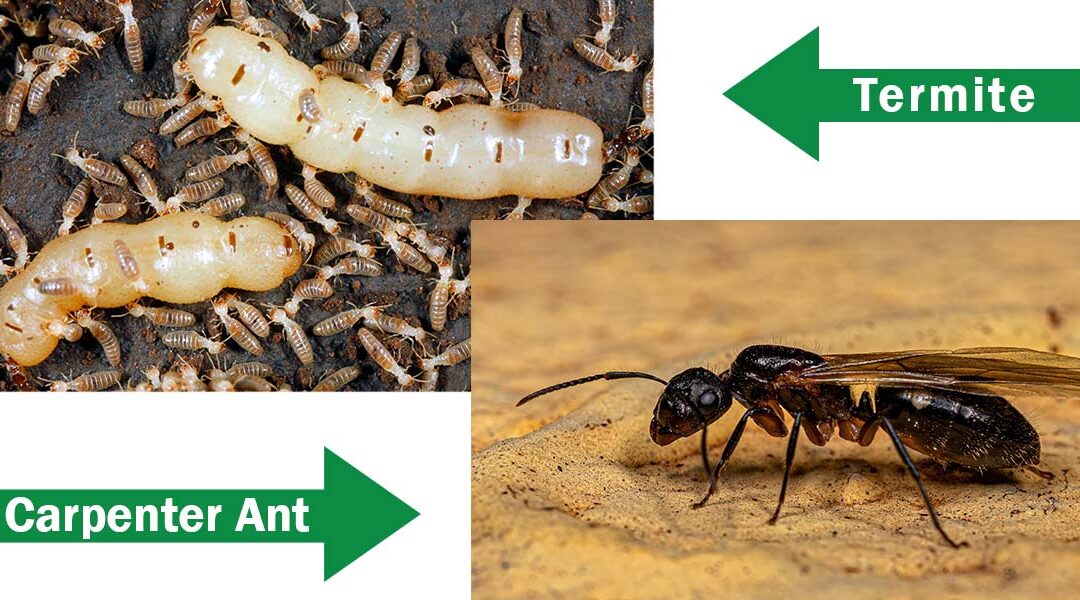Carpenter Ants or Termites, and How Do I Tell Them Apart?
When it comes to safeguarding your home from pests, understanding the threat posed by different insects is crucial. Among the most worrisome invaders are carpenter ants and termites. Both can cause significant damage, but their impact and the signs of their presence differ.
Carpenter Ants vs Termites
In an ongoing battle for the title of the most destructive home invaders, carpenter ants and termites often come up as primary suspects. Both pests are notorious for their ability to undermine the structural integrity of homes, but they do so in distinctly different ways.
Next, we’ll examine the nature of these pests, compare their destructive capabilities, and provide you with actionable tips to distinguish between them.
The Destructive Power of Termites
Termites are often called “silent destroyers” due to their ability to cause extensive damage without immediate detection. Here’s why they are so destructive:
- Diet. Termites feed on wood, breaking it down with the help of gut protozoa that digest cellulose, the main component of wood. This constant eating can hollow out wooden structures, leading to weakened support beams, floors, and even walls.
- Colony size. Termite colonies can be massive, with some subterranean termite colonies reaching into the millions. Such large numbers mean they can cause widespread damage quickly.
- Mud tubes. Subterranean termites build mud tubes to travel safely from their nests in the soil to wood sources. These tubes are a clear sign of termite activity, often found on foundation walls or along wooden structures.
Also, damage appearance. Termite damage often looks like water damage at first glance, with wood appearing to be soft, swollen, or even with a honeycomb texture.
The Damage by Carpenter Ants
While carpenter ants don’t actually consume wood, they are no less problematic:
- Nesting. Carpenter ants excavate wood to create smooth, clean galleries where they nest. Unlike termites, they do not eat wood but create tunnels and chambers, which can weaken structural integrity over time.
- Moisture preference. Carpenter ants are attracted to wood that is damp or decaying, often starting their nests in areas where water damage has already occurred, thus exacerbating the issue.
- Frass. Carpenter ants produce frass, which is a mixture of wood shavings and other debris. Finding these small piles can be a sign of an infestation.
Again, damage appearance. The damage from carpenter ants is typically neater with smooth tunnels, unlike the rough, mud-filled galleries of termites.
Comparing Damage and Costs
- Economic impact. Termites are responsible for billions in property damage annually in the U.S. alone, significantly more than carpenter ants. However, this doesn’t mean carpenter ants are benign; their damage, while slower to manifest, can still lead to costly repairs.
- Speed of damage. Termites tend to cause damage more rapidly due to their feeding habits. Carpenter ants, while less aggressive in their damage, can still cause significant structural issues if left unchecked.
How to Tell Carpenter Ants and Termites Apart
Identifying whether you have termites or carpenter ants is crucial for effective pest management. Here’s how you can distinguish one from the other:
- Wings. Both have winged swarmers, but termite wings are uniform in size, and both pairs are the same length. Carpenter ants have larger front wings compared to their back wings.
- Body shape. Termites have a uniform, broad waist, while carpenter ants have a narrow “waist” or pinched segment between the thorax and abdomen.
- Antennae. Termite antennae are straight, while carpenter ant antennae are bent or elbowed.
- Swarming. Both termites and carpenter ants swarm to mate, but termites often swarm in spring, while carpenter ants might swarm at different times, depending on the species.
- Nest locations. Termites mainly nest underground or in wood with direct soil contact, whereas carpenter ants nest in various wood sources, especially damp wood.
- Damage indicators. Mud Tubes for termites vs. clean, smooth tunnels for carpenter ants. Frass or sawdust from carpenter ants, contrasting with the mud and wood residue from termites.
While both termites and carpenter ants pose significant threats to homes, termites are generally more destructive due to their wood-eating habits and larger colony sizes. However, carpenter ants should not be underestimated; their preference for moist, rotting wood can lead to severe structural damage if not addressed.
Actionable Steps You Can Take
Regardless if it’s carpenter ants or termites, you need to be both proactive and vigilant to keep any species of pest at bay. You can do this with:
- Regular inspections. Check for signs like mud tubes, frass, or wood damage.
- Moisture control. Address any water leaks or damp areas to deter carpenter ants.
- Professional help. If you suspect an infestation, contact a pest control expert who can differentiate between the pests and treat them accordingly.
Understanding these pests, recognizing their signs, and acting promptly can save you from the considerable expense and headache of extensive home repairs. Remember, prevention is always better than cure when it comes to these wood-destroying insects.
Trust the Experts in Carpenter Ant and Termite Control!
Jacksonville homeowners and business owners, don’t let carpenter ants and termites wreak havoc on your property! Trust Trad’s Pest Control, your local experts in dealing with these destructive pests. With years of experience and proven techniques, our team knows how to efficiently eliminate carpenter ants and termites, ensuring your property stays safe and sound.
Contact Trad’s Pest Control today at 904-733-7488 to schedule a consultation. Let our expertise give you peace of mind and protect your investment. Your property deserves the best, and we’re here to deliver!

